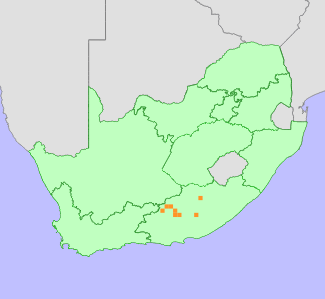|
Scientific Name | Conium hilliburttorum Magee & V.R.Clark |
Higher Classification | Dicotyledons |
Family | APIACEAE |
National Status |
Status and Criteria | Near Threatened D2 |
Assessment Date | 2022/04/28 |
Assessor(s) | H. Mtshali & V.R. Clark |
Justification | This locally uncommon species occurs in a restricted habitat, and has an area of occupancy (AOO) of 36 km². There are between seven and nine locations that are potentially threatened by invasive alien plant species. It is therefore listed as Near Threatened under criterion D. |
Distribution |
Endemism | South African endemic |
Provincial distribution | Eastern Cape |
Range | This species is endemic to the Eastern Cape Midlands Escarpment, occurring on the Sneeuberg, Great Winterberg-Amatholes, and Stormberg Mountains. |
Habitat and Ecology |
Major system | Terrestrial |
Major habitats | Karoo Escarpment Grassland |
Description | It is found in loamy clay soils, on moist, shaded, cool south-facing slopes and along cliff-bases. |
Population |
This locally uncommon species occurs in a restricted habitat. The population is estimated to comprise of more than 10 000 mature individuals and it is not suspected to declining. However, this species' habitat is potentially threatened by invasion by non-native plants. Population monitoring is required to better understand this species' risk of extinction.
|
Population trend | Unknown |
Bibliography |
Magee, A.R. and Clark, V.R. 2017. Mzansi's mountain hemlocks: The identities of Hilliard and Burtt's Conium species 3 and 4 (Apiaceae) and a revised key for the genus in sub-Saharan Africa. South African Journal of Botany 108:243-247.
|
Citation |
| Mtshali, H. & Clark, V.R. 2022. Conium hilliburttorum Magee & V.R.Clark. National Assessment: Red List of South African Plants version 2024.1. Accessed on 2025/11/18 |
 Comment on this assessment
Comment on this assessment

